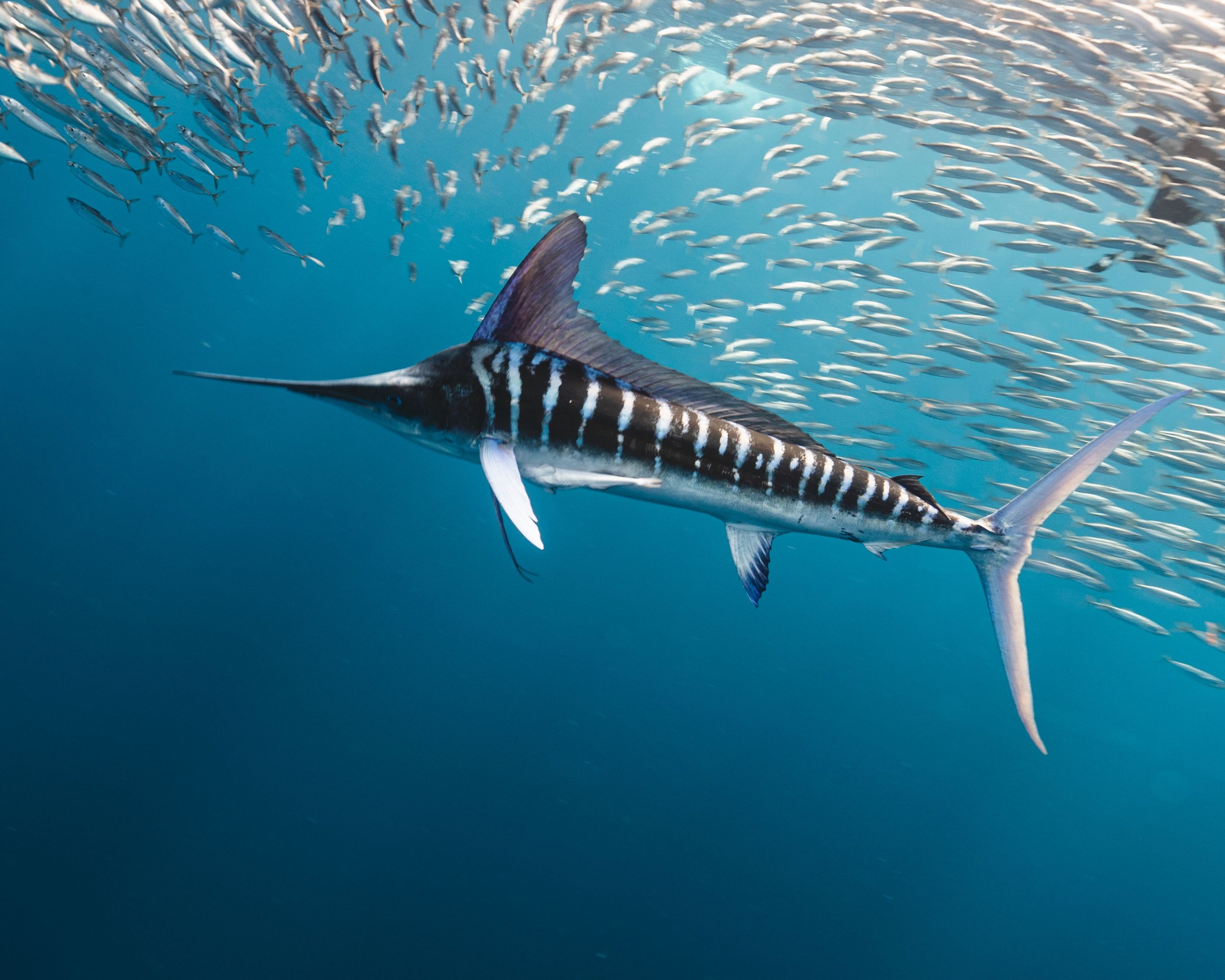New Study Reveals the Diving Behavior of Black and Striped Marlin
Black marlin and striped marlin are large, fast-swimming, oceanic predators that are increasingly being caught by fisheries in the Indian Ocean
We tracked the movements of 73 individual marlin with tags that recorded depth and temperature data, to investigate their diving behavior
Billfish (which include marlin) are among the fastest swimmers, reaching speeds of over 30 km h-1 in short bursts; our tagged marlin covered up to 14 vertical kilometers in a day
Both species dove extensively, reaching maximum depths of over 460 m, while spending most of their time in the top 20 m of the water column
Their depth distribution means that they are susceptible to being caught in gillnets and longlines, with ~50% of their time spent above 20 m depth where gillnets are used, and a near-complete vertical overlap with longlines that extend to 400 m depth.
Photo Credit: Julia Bahlsen
A new study by the Marine Megafauna Foundation (MMF) and research collaborators has been published in the journal Marine Ecology Progress Series, investigating the diving behavior of black and striped marlin. The authors, and participating sport fishing guides, deployed satellite tags on marlin off Kenya to track their movements. This is the first study into the diving behavior of these species in the Indian Ocean and highlights that the two marlin species have differences in their diving behavior, which allow them to both be successful, even when sharing the same habitat.
Black and striped marlin reached maximum dive depths of over 460 m, temperatures as low as 10 °C, and dove into waters with low oxygen concentration, but they both spent most of their time in shallower, warmer waters. Striped marlin descended deeper more frequently than black marlin, but they also spent more time in the top 5 m of the water column. Dr. Chris Rohner, lead author of the study and a Principal Scientist with MMF, explains, “striped marlin often hunt squid in deep water. After a deep dive into cold water, they have to warm up at the surface before they resume hunting. In contrast, black marlin largely stayed closer to the surface, in the warmer mixed layer, where they were likely hunting fish.”
Depth and temperature use by (A,C) black marlin and (B,D) striped marlin, with panels C and D zooming into the highly-used habitat between the surface and 100 m depth and between 20 and 32°C
Roy Bealey, billfish expert and a co-author of the study, adds, “we often see striped marlin, but rarely black marlin, basking at the surface, showing no interest in fishing lures. Our new data suggest that these striped marlin are probably recovering from deep dives, rather than searching for prey in surface waters.”
Tagged marlin dove deeper during the day than at night, but there were some differences between the species. Most striped marlin displayed a typical diel pattern, diving deeper during the day than at night, whereas black marlin dove particularly deep at sunrise and sunset. “Black marlin seem to specialize in hunting prey that migrate up from the depths towards the surface at sunset, and then return to the deep at sunrise. The marlin intercept them when they’re vulnerable – there’s enough light for the marlin, which are visual predators, to still see them,” explains Dr. Clare Prebble, Senior Scientist with MMF and a co-author of the study.
Billfish swim fast and are notoriously difficult to track with external tags. Two of the tags that were retrieved provided the first insights into why it is difficult to keep satellite tags attached to marlin. In both cases, the tags recorded positive depth values just before they detached. Dr. Bernerd Fulanda from Pwani University in Kenya elaborates: “The high-resolution depth records of these tags showed that the marlin breached the water surface; the tags came off as the fish splashed back into the water. This is the first evidence that free-jumping causes tag loss in marlin.”
High-resolution depth and temperature data at 3 second intervals from 2 recovered black marlin tags showing evidence of ‘free-jumping’ immediately prior to losing the tags. The water surface is indicated by a horizontal blue line. (A,B) Full depth and temperature time-series; arrows point to the ‘free-jumping’ event above the water surface after which the tag floats at the surface. (C,D) Zoomed in view of the jumps, showing the depth and absolute vertical speed. Note that the black marlin with tag #159242 made an earlier jump on 23 January 2018 without dislodging the tag
Being highly active also means that marlin have high energetic demands and require plenty of oxygen. Oxygen minimum zones, where oxygen levels are below 150 μmol kg−1, were thought to largely exclude marlin. However, the marlin tracked in this study dove into such low oxygen waters. “We were surprised to see marlin using these low oxygen areas. It is possible that the extended time spent at the surface also allowed them to re-oxygenate after dives,” explains Dr. Rohner. “Climate change is causing oxygen minimum zones to expand vertically towards the surface, which means that marlin might have to spend more time recovering and less time hunting at depth, as their habitat shrinks.”
Both marlin species had a high overlap with the depths in which different fishing gears operate. “Gillnets catch most of the billfish in the Indian Ocean. Our tracking study showed that black and striped marlin overlap with the depth of gillnets for more than half of the time,” says Dr. Samuel Williams from the Queensland Department of Agriculture and Fisheries. “Because both marlin species dived deeper during the day, they were less susceptible to gillnets during the day compared to during the night. This is useful information for fisheries managers.”
Dr. Simon Pierce, MMF Founder and co-author of the study, explains that “commercial catches of billfish in the Indian Ocean are increasing. Some marlin are already being overfished. We don’t even have any abundance data for some species. This study has a lot of useful information for fisheries management, but these amazing ocean speedsters clearly need a lot more attention.”
Notes to Editors
This study was led by the Marine Megafauna Foundation in collaboration with researchers from Pwani University, Kenya, the Department of Agriculture and Fisheries QLD, Australia, and the Pelagic Fisheries Consulting Ltd, UK. Funding was provided by a private trust.
Christoph Rohner, Roy Bealey, Bernerd Fulanda, Clare Prebble, Samuel Williams & Simon Pierce (2022) Vertical habitat use by black and striped marlin in the Western Indian Ocean, Marine Ecology Progress Series.
For questions about this press release, please contact:
Dr. Chris Rohner – Principal Scientist, Marine Megafauna Foundation
Email: chris@marinemegafauna.org
The Marine Megafauna Foundation (MMF) was created in 2009 to research, protect, and conserve the populations of threatened marine megafauna around the world. MMF’s headquarters are located in Tofo, Mozambique, where they operate as Associação Megafauna Marinha (AMM). ‘Megafauna’ are large marine species such as sharks, rays, and sea turtles. For further details, please see www.marinemegafauna.org or follow us on Instagram, Facebook, Twitter, and LinkedIn.












